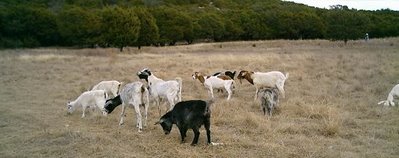Farmers and Ranchers Must Be Optimists
Julie Tomascik posted a blog entry yesterday, entitled "Farmers: The eternal optimists", on Texas Ag Talks. In it, she points to the insanity of those of us who grow the food that we serve on our tables. She wrote:
Farming and ranching is a gamble. Every year. And 2016 has been a mixed deck at best.
It flooded. Then the rain shut off. Drought now steadily creeps back in.
Anti-agriculture crowds continue to attack farmers and ranchers, while regulations are piled on. Increased costs for inspections, fees and certifications add to the growing list.
Commodity and livestock prices are down. Net farm income keeps dropping. And it’s forecast to be down 3 percent this year at $54.8 billion, the lowest since 2002.
Most would walk away. Throw in the towel and find a less stressful, more predictable career.
The sad fact is that many of us have walked away. But, we all need to eat. We do not want most of our incomes to go toward the cost of food. This means that either we import more food from abroad or we hire low-cost labor to grow and harvest our food. Actually, we are doing both.
We are importing beef from Argentina, fresh vegetables from Mexico, fresh fruit from Central America and packaged foods and beverages from just about every major nation. Importing food makes us vulnerable other nations' problems &ndash political, economic, climate and natural disasters. How do we, as a nation, stand up to another nation who provides a significant amount of our food? The answer is that we cannot, for if they decide to cut us off we are going to pay more to get our food from elsewhere or go hungry.
Farmers and ranchers are also hiring workers, when they can get them. Few Americans want to work in the hot sun, tending to and harvesting our fresh fruits and vegetable. To be honest, it is hard, sweaty work. If you are tending to livestock, it can be dangerous, as well. The price the farmer or rancher receives for what they produce is set by the buyers for supermarkets and processing plants. From the amount the buyers pay, the farmer must pay for the seed, the fertilizer, the water, the pest managers and the harvesters. Precious little, seldom more than pennies per pound, is kept by the farmer.
Think about it. For a farmer who grows melons exclusively, take a minute and calculate how many melons must be sold to earn a reasonable "paycheck." Yesterday, cantaloupes were selling for $0.95 each and honeydews for $1.19. Of that, the grower may get $0.35. When you subtract the grower's costs to grow and harvest that melon, the grower gets to keep about 7 cents. If the grower wants an income of $40,000, that takes about 571,500 melons! More than half a million melons! That is a whole lot of melons! You can do a similar calculation with any food item.
Given these statistics, and the fact that each crop is a big gamble, why do we choose do it? Each of us has our own answer. Would you city dwellers or suburbanites do it? Probably not. You would rather fight with traffic, put up with noise and crowding, than take on our risks. Most of you cannot even be bothered to raise a garden &ndash "It's too hard." "I haven't got time." "It's too much work."
Your garden would be measured in square feet. Our "gardens" are measured in acres and square miles. Feeding you sure keeps us busy!
Labels: farming, Julie Tomascik, ranching, Texas Ag Talks




0 Comments:
Post a Comment
<< Home